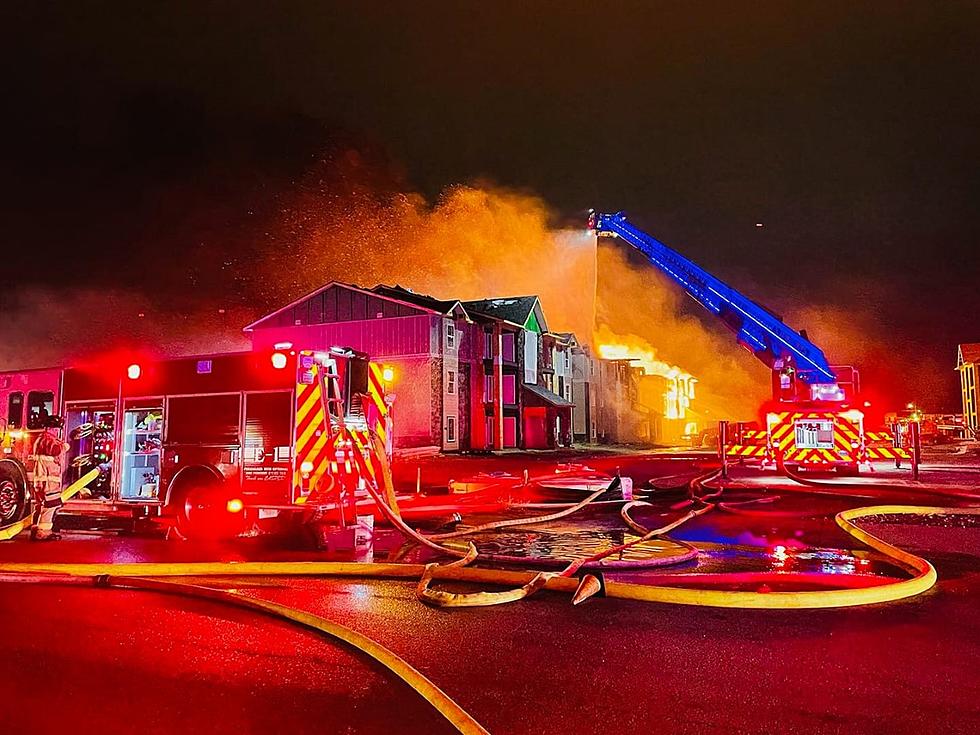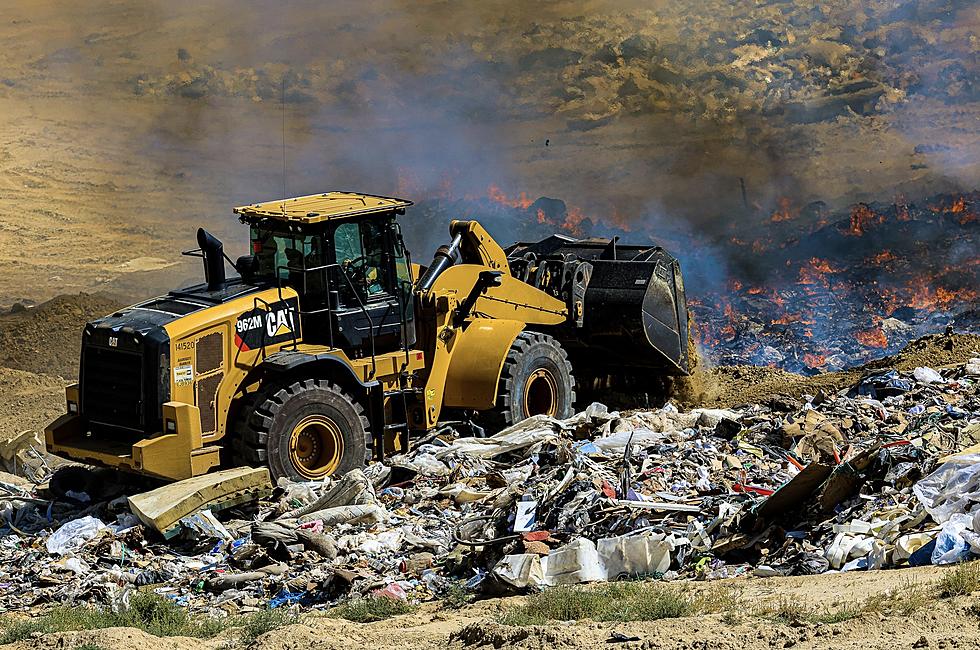
Mills Fire Chief Addresses Allegations Made Regarding Apartment Complex Fire
Months after a fire raged through an apartment complex in the City of Mills, new information is being brought to light on whether the Mills Fire Department ran out of water while fighting the fire.

According to a press release from the Mills Fire Department, "The structure fire that occurred on March 4th, 2022 at the Cornerstone Apartment complex on Poison Spider Road was caused by combustible material stacked too close to an ignition source, leading to the fire. The fire occurred in one of two unfinished buildings, consisting of 36 individual apartments, which were nearing completion."
Leah Juarez, a citizen of Mills and a mayoral candidate, took to social media to make some startling allegations against the City of Mills and the support that was offered to the Mills Fire Department during the 26-hours-long fire.
"With a lot of back and forth, and the help of the City of Casper, I was able to recover the records," Juarez wrote on social media. "The information I received that morning was correct: Mills ran out of water."
Juarez stated that she had spoken with various officials, as well as firefighters, regarding what happened that night.
"The firefighters lost water pressure multiple times," Juarez wrote. "They were forced to move loops throughout the fight due to Mills’ outdated and inadequate water line system. At one point they lost all water resulting in the fire picking up again. The firefighters radio called Mills officials to 'increase water pressure' with the Mills water official stating there was no ability to put out more water.
Read More: Investigators Determine Cause Of Mills Apartment Fire
"If an ember from the apartment fire had started another home on fire, Mills would not have the water to put it out. Luck was on our side. Experience and problem solving was on the side of the fire fighters."
Juarez created a video featuring images from the fire, as well as recordings of the radio chatter that transpired throughout the fire, in which firefighters stated that they were losing pressure, that a fire hydrant they were trying to connect to was not working, that another hydrant was weak, that they were at critical water levels, and that all units had to shut down water supply.
"I just lost water," one firefighter stated.
Juarez told K2 Radio News that she had received an 8-minute long video of the radio chatter that occurred on that night from the City of Casper.
"[The video] did confirm a lot of what the firefighters were saying - that they were having pressure issues, that they were having broken hydrants that were not attached, that they were losing water, that they were having to switch loops multiple times just to combat the fire."
Those allegations are damning but Wil Gay, the Fire Chief for the Mills Fire Department, is saying they're not true.
In an exclusive, K2 Radio News asked Gay, point blank, if the City of Mills ran out of water during the night of the apartment complex fire.
He said no.
"I guess what's being missed here is that this is probably one of the largest fires that Natrona County's ever seen," Chief Gay stated. "For most of the firefighters that were on this fire, they will never see a bigger fire."
Because of the sheer size of the fire, and the fact that it was a gas-fed fire, firefighters faced unusual circumstances in trying to fight it.
"One of the allegations is that we completely shut down, and then the fire grew and that's not true," Chief Gay said. "Even on that radio chatter of the video [Juarez] did with the drones and that, there was always water flowing to some extent; not necessarily the Ladder Truck, the ARFF (Aircraft Rescue and Firefighting) Truck from the airport and big guns like that, but there was always water going on the fire."
The press release goes into more specifics.
"Due to the large volumes of water used for suppression efforts, the Mills water system went into alarm and fire flows needed to be reduced for a short amount of time until crews could change from the low-pressure system to the high-pressure system, preventing the City from having to issue a boil order for its residents," the release stated. "This allowed the water system to operate normally and not enter into failsafe mode. At one point during the fire, crews had deployed a combination of five (5) ground and aerial monitors, flowing a combined 2500-4000 gallons per minute and used a total of 2.66 million gallons of water by the time the fire was under control.
Read More: PHOTOS: Casper Fire-EMS Offers Update, Insight Into Mills Apartment Fire
"On the night of the fire, personnel from the City of Mills water department were able to monitor the water levels and control valves manually to ensure crews were able to continue in their suppression efforts using the high-pressure system. While there was a pause in maximum suppression efforts to allow crews to establish water supply on the high-pressure system, water was continually being flowed."
Chief Gay stated that the approximate time it took to switch lines and make the overall adjustment was about 45 minutes.
"Part of [the reason for] that was because the hydrant we hooked to, it was 1500 feet away from Casper Fire's Engine 1 that was sitting on Poison Spider feeding the ladder truck, and it took two different engines to be able to lay that hose," Gay said. "It just took time to get the lines laid out, hooked back up, and then they did what was called the Relay Pump. The Ladder Truck from Glenrock was sitting at the hydrant in front of Triggers (a gun shop located near the Buckin' Brew Coffee Shop in Mills). The Ladder Truck was sitting there, basically, to boost the pressure that was coming from the hydrant to him. He fed to our engine that was sitting behind The Maverick (a gas station in Mills), and then they pushed it to Engine 1 from the City [of Casper], which then ultimately fed the Ladder Truck."
Juarez stated that the Mills City Council, both the current and previous incarnations, inadvertently put up multiple hurdles for the firefighters on that night.
"It's really unfortunate that the decisions that the council has made; not only this council, but councils before, had set that crew up for so many hurdles that they had to overcome," she said. "Yes, the guys are creative and they prepare for things like this all the time, but that doesn't excuse the fact that Mills did not have the pressure, and on the radio chatter, you could hear the firefighters saying 'We need to contact the Mills officials, we need to turn the pressure up, we do not have enough pressure.'"
Gay doesn't disagree with the fact that it was possible, at one time, that they lost pressure. But he said there was a good reason for that.
"Everybody at that initial stage of the fight was hooked to the same line," he said. "So it's quite possible that all the engines that were hooked to the hydrants were trying to pull more than what the system was designed to push. And I'm not aware that that's something that the city can just go in and say, 'Oh, well you need more pressure? Here, let's just bump it up.' I don't believe the water system works that way."
Read More: Mills Fire Chief Dispels Rumors Regarding Friday Night Blaze
Juarez claims that the events of March 6 are just an example of the larger picture of the bigger problem in Mills, which is that the city just simply does not have enough water for its residents.
"Now when I look back at the attempt to take over Wardwell Water District, the emergency session to drill a water well, the funding for the additional water tower, and the summer water restrictions, it all makes sense," she wrote. "Mills does not have enough water for the residents currently. Let alone the new annexation, the new construction, and the new apartment complex. Mills’ water treatment facility is at near capacity for output. It’s water tower is not large enough to meet the demands of the city."
Chief Gay is disputing that allegation as well. He said that he spoke with the Mills Water Treatment Plant Supervisor and found out that "The City of Mills stores 4 million gallons of water between three storage tanks. On a worst-case scenario in the middle of summer, the city might see a 1.5 million gallon per day usage by its residence. On a continual basis, it would take 12-14 hours to replenish the 1.5 million gallons."
Despite the capacity, however, Mills did issue a "water usage alert' in June of last year.
Additionally, Oil City News reported that, earlier this year, Mills adopted emergency measures to replace water wells in order to avoid potential usage restrictions.
Chief Gay stated that that Water Treatment Plant Supervisor told him that, "In the middle of summer, at a hundred degrees, she said that would be their worst-case scenario, if Mills residents drew down 1.5 million gallons, just because it's summertime and there's more water usage, the city has the ability to fill the tanks back up. It just takes 12 to 14 hours, which still isn't a full day and still isn't half the capacity of the tanks."
K2 Radio News asked Chief Gay if, at any point, firefighters felt as though they were "betrayed" or "left hanging" by the City of Mills.
Again, he said no.
"If anything, it was more of our understanding of how the water system was laid out," he offered. "And once Public Works came up and basically said, 'Look, everybody's hooked to the same loop; you guys need to get on a different loop,' we identified the two closest hydrants that would put us on that other loop. And once we did that, we didn't have any other issues."
Juarez also stated that a fire hydrant that had been knocked over by a car running into it could have also contributed to problems containing the fire.
"Early in the night they attempted to connect to a hydrant which fell over," she wrote. "It was a hydrant that the neighbor had called on twice to have repaired after a driver hit it. It was never repaired."
Chief Gay said that didn't actually matter.
"That was a moot point as far as the firefight goes because, again, it's tied to the same loop as all the other hydrants that were being used," he said. "Probably, ultimately, it would've caused more problems because you would have had an additional truck trying to pull off the same line as everyone else."
Chief Gay, once he learned of the allegations that Juarez was making regarding the City of Mills, took it upon himself to learn more about the Mills Water Treatment Facility and how it pertained to March's fire, as well as potential future fires. He spoke with supervisors and tried to understand as much as he could about how water systems actually work.
"I would just have to say, based on everything I've learned about the water system after this fire, I believe the city has the required amount of water necessary to supply to the residents," he said.
K2 Radio News will continue to update this story, as well as the larger story at hand, as more information becomes available.
Apartment Fire in Mills, Wyoming
More From K2 Radio









